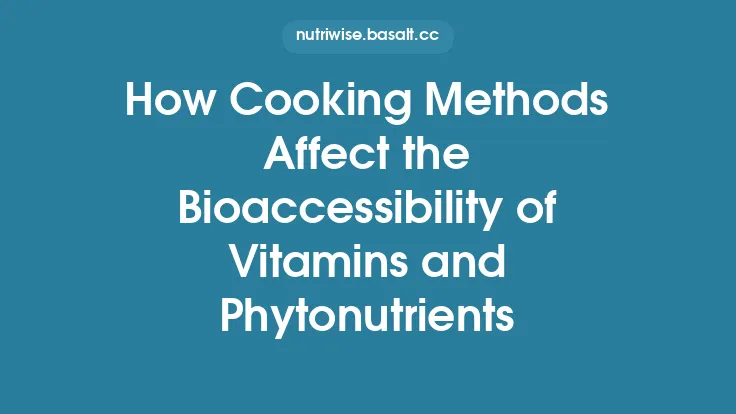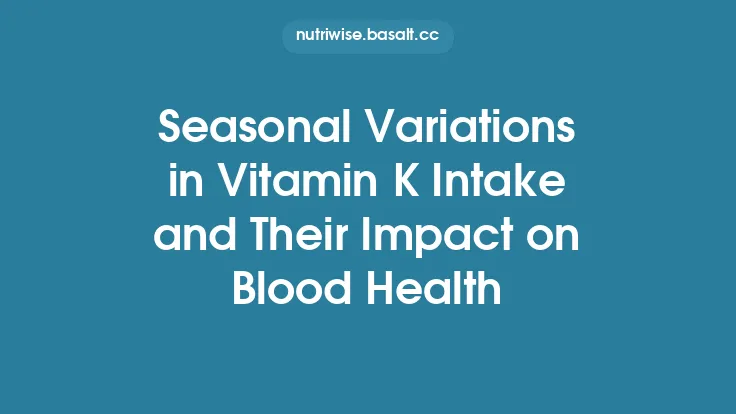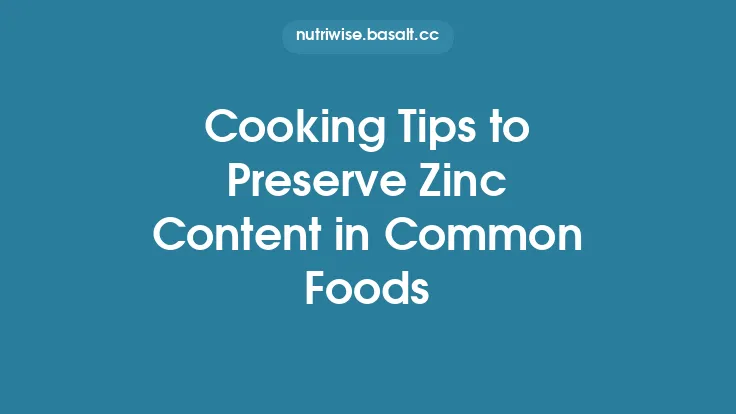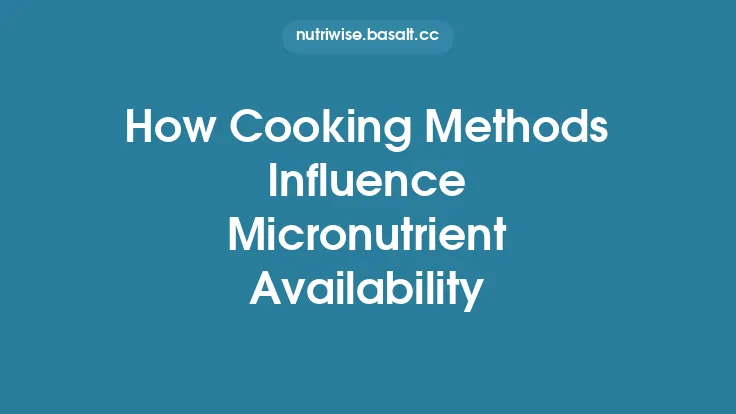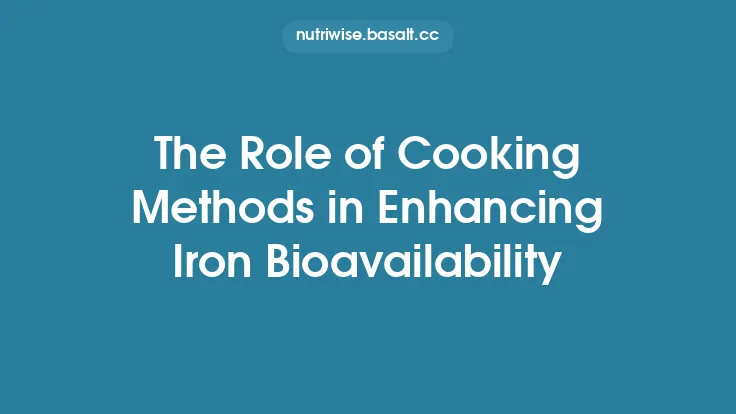Vitamin K is a fat‑soluble micronutrient that plays a crucial role in the activation of clotting factors, but its nutritional value can be markedly altered by the way foods are prepared. While raw vegetables, leafy greens, and certain animal products are naturally rich in vitamin K, the cooking process can either preserve, degrade, or even enhance its availability depending on temperature, moisture, exposure to oxygen, and the presence of lipids. Understanding the chemistry behind vitamin K stability and the practical implications of common cooking techniques enables both clinicians and home cooks to make informed decisions that support optimal blood‑coagulation health without compromising flavor or texture.
Understanding Vitamin K Stability During Heat Processing
Vitamin K exists primarily as phylloquinone (vitamin K₁) in plant foods and as a group of menaquinones (vitamin K₂) in animal products and fermented foods. Both forms share a naphthoquinone ring with a long isoprenoid side chain, which confers lipophilicity and susceptibility to oxidative degradation. The key factors influencing stability are:
| Factor | Effect on Vitamin K | Mechanism |
|---|---|---|
| Temperature | Moderate heat (≤ 100 °C) generally preserves K₁; temperatures above 150 °C accelerate oxidation and isomerization. | Thermal energy breaks the conjugated double bonds in the side chain, forming epoxides and hydroperoxides that are biologically inactive. |
| Moisture | Water alone does not hydrolyze vitamin K, but leaching can occur when the food matrix is disrupted. | Soluble components of the cell wall release vitamin K into cooking water, especially during prolonged boiling. |
| Oxygen exposure | Oxidative loss is significant in the presence of air, especially at high temperatures. | Reactive oxygen species attack the quinone ring, converting it to quinone‑derived polymers. |
| pH | Alkaline conditions (pH > 8) promote degradation; acidic environments are more protective. | Base‑catalyzed hydrolysis of the side chain accelerates breakdown. |
| Lipid environment | Presence of dietary fat protects vitamin K from oxidation by sequestering it within micelles. | Lipid bilayers limit oxygen diffusion and provide a non‑polar medium that stabilizes the molecule. |
Overall, vitamin K is relatively heat‑stable compared with many water‑soluble vitamins, but it is not immune to loss, especially when cooking methods combine high temperature, prolonged exposure, and ample oxygen.
Impact of Moist‑Heat Methods (Boiling, Steaming, Microwaving)
Boiling
Boiling is the most common method for preparing leafy greens such as kale, collard greens, and spinach. Studies measuring vitamin K₁ content before and after boiling report losses ranging from 10 % to 30 %, depending on cut size, cooking time, and water volume. The primary mechanisms are:
- Leaching: Vitamin K, though lipophilic, can be released from disrupted cell membranes into the cooking water, especially when the tissue is finely chopped.
- Thermal oxidation: Prolonged exposure to boiling temperatures (100 °C) in the presence of dissolved oxygen accelerates oxidative breakdown.
Practical tip: Use the minimal amount of water needed to cover the vegetables, keep the lid on to reduce oxygen exposure, and limit cooking time to the point of tenderness (usually 3–5 minutes for leafy greens). Re‑using the cooking water in soups or sauces can recover leached vitamin K.
Steaming
Steaming subjects food to saturated steam at 100 °C but eliminates direct contact with water, dramatically reducing leaching. Comparative analyses show 5 %–15 % loss of vitamin K₁ after 5–10 minutes of steaming, making it one of the most retention‑friendly methods. The protective effect stems from:
- Limited water interaction: The food’s surface remains relatively dry, preserving the lipid matrix that houses vitamin K.
- Reduced oxygen diffusion: The steam environment is less turbulent than boiling water, limiting oxidative exposure.
Practical tip: Arrange leaves in a single layer to ensure even steam penetration, and avoid over‑steaming; a quick “blanch‑steam” (2–3 minutes) is sufficient for most greens.
Microwaving
Microwave heating rapidly raises the temperature of water molecules within the food, often achieving temperatures of 80–95 °C in seconds. Because the process is short and typically performed in a covered container, vitamin K loss is minimal—often under 10 %. However, the presence of a small amount of added water can still cause some leaching.
Practical tip: Use a microwave‑safe cover to trap steam, add only a tablespoon of water for leafy greens, and heat in short bursts (30‑second intervals) until just wilted.
Dry‑Heat Methods (Roasting, Grilling, Baking)
Dry‑heat techniques expose food to higher temperatures (150–250 °C) without added moisture, which can both protect against leaching and increase oxidative stress.
Roasting
Roasting vegetables such as Brussels sprouts, carrots, or cauliflower at 180–200 °C for 20–30 minutes typically results in 15 %–25 % vitamin K loss. The loss is mitigated when the vegetables are tossed with oil before roasting:
- Oil acts as a protective barrier, sequestering vitamin K within the lipid phase and limiting oxygen diffusion.
- Caramelization and Maillard reactions generate antioxidant compounds (e.g., phenolics) that can partially offset oxidative degradation.
Practical tip: Coat vegetables lightly (1–2 teaspoons per cup) with a stable oil (e.g., olive or avocado) and roast on a single layer to ensure even heat distribution.
Grilling
Grilling subjects food to direct radiant heat and often reaches surface temperatures above 250 °C. Vitamin K loss can be up to 30 % for leafy greens or herbaceous vegetables, primarily due to:
- Charring: High temperatures cause surface carbonization, destroying the vitamin in the charred layer.
- Oxidative environment: Open flame introduces abundant oxygen.
Practical tip: Use indirect grilling (placing food away from direct flame) and flip frequently to avoid excessive charring. For leafy greens, consider grilling in a foil packet with a drizzle of oil to create a semi‑sealed environment.
Baking
Baking breads, pastries, or casseroles that contain vitamin K‑rich ingredients (e.g., kale chips, cheese) typically involves temperatures of 180–220 °C for 30–45 minutes. Vitamin K loss is variable but generally 10 %–20 %, depending on the matrix:
- Dairy‑based matrices (e.g., cheese) protect vitamin K₂ due to the high fat content.
- Low‑fat matrices (e.g., vegetable‑only casseroles) are more susceptible to oxidation.
Practical tip: Incorporate a modest amount of healthy fat (e.g., cheese, nuts, or oil) into baked dishes to improve vitamin K retention.
Frying and Sautéing: Role of Fat and Temperature
Frying (deep‑fat) and sautéing (pan‑cook) expose food to temperatures of 160–190 °C in an oil medium. Counterintuitively, these methods can preserve or even enhance vitamin K availability when performed correctly:
- Lipid solubility: Vitamin K dissolves readily in cooking oil, which shields it from oxidative degradation.
- Reduced leaching: No water is present to extract the vitamin.
- Short cooking times: Quick sauté (2–4 minutes) limits thermal exposure.
However, excessive heating or reuse of oil can generate free radicals that oxidize vitamin K. Studies show that fresh oil and moderate temperatures keep vitamin K loss below 10 %.
Practical tip: Use stable oils with high smoke points (e.g., avocado, refined olive, or grapeseed oil), avoid overheating, and discard oil after a single use when cooking vitamin K‑rich foods.
Pressure Cooking and Sous‑Vide: Gentle Yet Effective
Pressure Cooking
Pressure cookers raise the boiling point of water to 115–120 °C under 15 psi, allowing foods to cook faster (often 5–10 minutes for greens). The sealed environment limits oxygen, and the reduced cooking time curtails both leaching and oxidation. Reported vitamin K₁ retention is 80 %–90 %.
Practical tip: Add a minimal amount of water (just enough to generate steam) and release pressure quickly (quick‑release) to prevent prolonged heat exposure.
Sous‑Vide
Sous‑vide involves vacuum‑sealing food in a plastic pouch and cooking it in a water bath at precisely controlled temperatures (typically 55–85 °C) for extended periods (1–4 hours). The vacuum eliminates oxygen, and the low temperature preserves heat‑labile nutrients. Vitamin K retention in sous‑vide‑cooked leafy greens exceeds 95 %, provided the cooking temperature stays below 85 °C.
Practical tip: Vacuum‑seal greens with a small amount of oil and a pinch of salt to enhance flavor and protect vitamin K. After cooking, quickly sear if desired for texture.
Effect of Food Matrix and Preparation Techniques
The intrinsic composition of the food—its fat content, fiber, and cellular structure—significantly influences how cooking impacts vitamin K.
- High‑fat matrices (e.g., cheese, butter, nuts) naturally protect vitamin K₂ by embedding it within triglyceride droplets, reducing exposure to oxygen.
- Cell wall disruption (e.g., chopping, shredding) increases surface area, which can accelerate leaching in water‑based methods but also improves oil absorption in dry‑heat methods, thereby enhancing retention.
- Pre‑blanching (brief boil followed by rapid cooling) can inactivate endogenous enzymes that might otherwise catalyze oxidative reactions during subsequent cooking steps.
Practical tip: When preparing leafy greens, consider a two‑step approach: a quick blanch (1 minute) to soften fibers, followed by a rapid sauté in oil. This maximizes texture while preserving vitamin K.
Practical Kitchen Strategies to Preserve Vitamin K
| Strategy | Rationale | Implementation |
|---|---|---|
| Add healthy fat early | Vitamin K is lipophilic; oil creates a protective micellar environment. | Toss greens with 1 tsp oil before steaming, roasting, or sautéing. |
| Minimize water volume | Reduces leaching and dilution of vitamin K. | Use just enough water to cover the pan; consider steaming instead of boiling. |
| Cover pots and pans | Limits oxygen ingress, slowing oxidation. | Keep lids on during boiling/steaming; use foil packets for grilling. |
| Short, high‑heat bursts | Limits total thermal exposure while achieving desired texture. | Sauté for 2–3 minutes; flash‑roast at 220 °C for 5 minutes. |
| Avoid repeated heating | Each reheating cycle compounds oxidative loss. | Cook once and serve; store leftovers cold and reheat gently (microwave low power). |
| Use fresh cooking oil | Degraded oil contains peroxides that accelerate vitamin K oxidation. | Discard oil after a single high‑heat use for vitamin K‑rich foods. |
| Incorporate antioxidant allies | Phenolics and vitamin E can scavenge free radicals, protecting vitamin K. | Add garlic, rosemary, or a squeeze of lemon juice during cooking. |
Summary of Key Takeaways
- Vitamin K is relatively heat‑stable but vulnerable to oxidation, leaching, and high‑temperature degradation.
- Moist‑heat methods (steaming, microwaving) preserve the most vitamin K; boiling leads to moderate losses due to leaching.
- Dry‑heat methods (roasting, grilling) can cause higher losses, but the presence of oil mitigates oxidation.
- Frying and sautéing are among the best techniques for retention when using fresh, high‑smoke‑point oils and avoiding overheating.
- Pressure cooking and sous‑vide offer excellent preservation by limiting oxygen and controlling temperature.
- The food matrix—especially fat content and degree of cellular disruption—plays a decisive role in how cooking impacts vitamin K.
- Simple kitchen practices—adding fat, limiting water, covering cookware, and avoiding repeated reheating—can substantially improve vitamin K retention without sacrificing flavor or texture.
By aligning cooking choices with the chemical nature of vitamin K, individuals can enjoy a diverse, delicious diet while ensuring that the micronutrient essential for proper blood coagulation remains available in the foods they consume.
